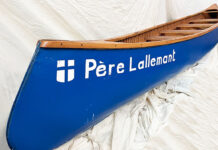A couple hours at the International Boat Show affirmed that everything old is new again.
The indoor, arena-sized pond hosted everything from paddlesports instruction to motorboat trials to crazy wakeboarding and water stunts throughout the weeklong show. I took the organizers up on a chance to try standup paddleboarding for the first time.
I admit it, from one canoeist to another, I was skeptical of the sport.
SUPs have been the wunderkind of the paddlesports world and a much-needed financial boom for manufacturers over the past five years. According to the Outdoor Industry Association, it was also the fastest growing sport in the United States last year.
At first, I thought SUP was a gimmick. “This will blow over,” we conventional canoeists told ourselves. The truth is far from it. “They’re out-selling canoes two-to-one,” a cheerful whippersnapper in a wetsuit told me, handing over a paddle. Fad or not, I was ready to dump my canoe—temporarily, of course—to have a go and see what the hubbub was about.
Waiver signed, PFD secured, watch and wallet tucked into my shoes on the makeshift dock, I should have accepted the counsel of the young man who suggested I begin on my knees and work up from there. (“A lot of the ladies are doing yoga on standup paddleboards these days,” he said brightly, “but it takes a minute to get your balance.”)
Not Captain Canoe, of course—being a gunwale-bobber from way back, I stepped right on and very nearly swam.
I began by J-stroking but changed to rhythmically switching the extra-long paddle from side to side to keep straight. Looking down at my bare feet, images from early days growing up with my faithful retriever, Princess, on the banks of the mighty Speed River came flooding back. Déjà vu.
In look, the SUP was more like a Carl-Wilson-autographed surfboard but in feel, it was a raft—childhood’s first vehicle of exploration, made of logs, bailer twine and old fencing wire—with improved hull shape and hydrodynamics. Here we go again, Huck Finn!
Lost in my raft revelry, I paddled easily, building up speed with every pull and push. Hoisting an imaginary Jolly Roger, I was again Bluebeard on the bounding main or Captain Hattaras on my way to the North Pole. The 21st-century design didn’t fool me—this was my paddlecraft of yore.
Of course, with little storage, no secondary stability and the requirement of standing all the time, the SUP remains an inferior craft to the canoe—but the child in me won’t hear of it.
Don’t worry, James Raffan hasn’t given up his canoe, but he is considering an Arctic SUP trip with raft support. He asks you not to be too disappointed.









